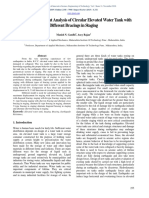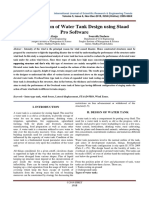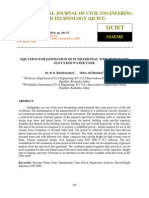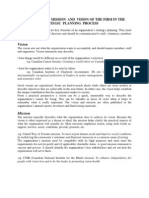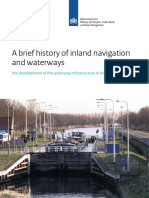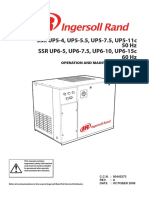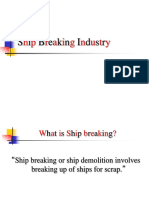Professional Documents
Culture Documents
Comparatively Design and Analyze Elevated Rectangular Water Reservoir With and Without Bracing For Different Stagging Height
Comparatively Design and Analyze Elevated Rectangular Water Reservoir With and Without Bracing For Different Stagging Height
Original Title
Copyright
Available Formats
Share this document
Did you find this document useful?
Is this content inappropriate?
Report this DocumentCopyright:
Available Formats
Comparatively Design and Analyze Elevated Rectangular Water Reservoir With and Without Bracing For Different Stagging Height
Comparatively Design and Analyze Elevated Rectangular Water Reservoir With and Without Bracing For Different Stagging Height
Copyright:
Available Formats
Volume 9, Issue 4, April – 2024 International Journal of Innovative Science and Research Technology
ISSN No:-2456-2165 https://doi.org/10.38124/ijisrt/IJISRT24APR1241
Comparatively Design and Analyze Elevated
Rectangular Water Reservoir with and without
Bracing for Different Stagging Height
1
Shankar Somwanshi; 2Vishal Lokhande; 3Kiran Sonavane; 4Ranjeet Patil; 5Bhushan Meher; 6 Javed khadgaonkar
6
Proffesor (Guide)],
1,2,3,4,5,6
JSPMS ICOER PUNE
Abstract:- A water tank, like a container that stores huge flames and consider able monetary loss. Present study
liquids, are categorized based on shape studies predict deals with the Comparative analysis and design of three
the analysis and design of rectangular as well as circular basic shapes of water tank rectangular water tank. Elevated
overhead water tanks through the usage of STADD PRO storage tanks are used to deliver water either through large
software. Storage reservoirs, especially overhead tanks, distribution system or through stand pipes located near to
serve the purpose of storing and distributing water to the source. Elevated storage tanks are used when ground
consumers. Water supply planning may not have been storage tanks cannot be built due to lack of sufficient natural
adequately done for the recently built Overhead Circular elevation and where standpipes are served from a powered
Tank to meet the increasing demands of the expanding pump.
urban population. Branched distribution systems could
be in several scenarios, including rural irrigation and the II. LITERATURE REVIEW
distribution of reclaimed water.
The passage outlines the significance of reinforced
Time is approaching when the need to conserve and concrete design and construction methods in various
store water becomes so essential. In such moments, it is structural projects, particularly focusing on water tanks.
crucial to develop cost-effective methods for storing and Here's a breakdown of the key points mentioned .
distributing water. The water that is stored in overhead Influence Factors: Reinforced concrete design and
water tanks is strategically placed. The overhead tank is construction methods are influenced by prevailing
vital as it serves as a common public utility structure. construction practices, material properties, and climatic
The distribution to nearby areas can be done without the conditions. These factors shape the approach taken in
need for pumping!!! The cost efficiency of overhead designing and constructing structures.
storage water tanks relies significantly on the quantity of StaadPro Analysis: The project involves analyzing the
concrete and steel needed for tank construction. entire structure using StaadPro software. Response
spectrum analysis conducted through StaadPro provides
As an initial resolution to this issue, it is essential to crucial parameters such as displacement, bending
develop a water storage project based on STAAD moment, shear force, axial force, torsion values, and
principles, famously known as Overhead Water cutting force. This analysis aids in determining the base
Reservoir. The current study covers the analysis and shear, essential for structural design.
design of an elevated circular water tank using Design Methodology: The design methodology
STAAD.Pro V8i. The design involves manual load employed in StaadPro analysis is Limit State Design.
calculations and the analysis of the entire structure using The water tank is subjected to various loads including
STAAD Pro V8i. The method of design used in the dead load, selfweight, hydrostatic load due to water, live
STAAD.Pro analysis is Limit State Design; the water load, and seismic loads.
tank is being subjected to various loads such as wind Seismic Load Calculations: Seismic load calculations are
load, deadload, self-weight, and hydrostatic load due to performed according to IS 1893- 2000 standards.
water. Response spectrum analysis helps in understanding the
structural response to seismic forces.
I. INTRODUCTION Tank Shape Analysis: Different tank shapes, including
rectangular, square, and circular, are analyzed using
A water tank stores water. Water tanks are used for StaadPro. The influence of shape factors on design loads,
many purposes including drinking water storage, stress distribution, and overall economy is discussed,
agricultural irrigation, fire suppression, plant and livestock emphasizing the importance of shape selection in tank
farming, chemical manufacturing, food preparation, and design.
many others. Elevated water tanks have a large water mass
Purpose: The primary purpose of these water tanks is to
at the top of narrow staging, which is important for failure. provide drinking water facilities in areas facing water
Raised water tanks are harm to essential and strategic scarcity issues. The analysis focuses on understanding
structures earthquakes may affect drinking water source of
IJISRT24APR1241 www.ijisrt.com 851
Volume 9, Issue 4, April – 2024 International Journal of Innovative Science and Research Technology
ISSN No:-2456-2165 https://doi.org/10.38124/ijisrt/IJISRT24APR1241
the behavior of elevated circular water tanks, considering methods are compared with results obtained from
various loading conditions as per Indian code guidelines. StaadPro and SAP software. This comparison helps in
Seismic Load Calculations: Seismic load calculations are optimizing reinforcement design and ensuring structural
performed according to IS 1893- 2000 standards. efficiency.
Response spectrum analysis helps in understanding the Overall, the passage highlights the comprehensive
structural response to seismic forces. approach taken in designing and analyzing reinforced
Tank Shape Analysis: Different tank shapes, including concrete structures, particularly focusing on water tanks,
rectangular, square, and circular, are analyzed using to meet safety, efficiency, and functionality
StaadPro. The influence of shape factors on design loads, requirements.
stress distribution, and overall economy is discussed,
emphasizing the importance of shape selection in tank III. RESULT & DISCUSSION
design.
Purpose: The primary purpose of these water tanks is to If any mistakes or errors are made in the load
provide drinking water facilities in areas facing water assessment, the design of the elevated tank will be based on
scarcity issues. The analysis focuses on understanding falsehood and may likely fail. Some types of load might
the behavior of elevated circular water tanks, considering require you to calculate them accurately based on the
various loading conditions as per Indian code guidelines. parameters you were presented with on how to determine
Storage Reservoirs: Storage reservoirs and overhead the design of the water tank. Some of the ways to accurately
tanks are crucial for storing water, petroleum, and determine load are the wind. Accurate wind assessment will
similar liquids. The force analysis of these structures help you assess load effectively, leading to a reliable design
ensures structural stability and integrity, irrespective of of the elevated water tank structure. A load is a combination
the stored product's chemical nature. Concrete structures of more than one load type that is weighing down the
must be impervious to prevent leakage, and underground structure . The building code usually contain numerous
tanks offer protection from natural disasters and damage. types of load combinations and their respective factors to
Comparison and Optimization: Manual analysis and ensure that the structure is safe, even when the maximum
design of underground water tanks using IS code load is assumed to be borne by the structure.
Fig 1: Shear Bending at 10M
IJISRT24APR1241 www.ijisrt.com 852
Volume 9, Issue 4, April – 2024 International Journal of Innovative Science and Research Technology
ISSN No:-2456-2165 https://doi.org/10.38124/ijisrt/IJISRT24APR1241
IV. METHODOLOGY
Phase-I
To Decide Aim, Objective and Need of Work
To Review Various Literatures, Codes and Journals
To decide the flow of work i,e Methodology
Phase-II
Detail Study of all possible Structural
Effect of Earthquake and Its parameter
Types of loading and Methods of Analysis
Fixing All general Structural Data and Case
Considerations of ModelsResults and Comparison
Phase –III
Analyzing all the selected model patterns
Drafting of Comparative result Statements
Discussing all obtained Results
Conclusions on results obtained after analysis and
Discussion
Objectives
Analysis and design of Elevated reservoirs by using
Staad pro.
Connect 99. Seismic analysis for Rectangular Elevated
water tank with and without bracing for different Fig 2: 3D View without Bracing 15M ht
staging.
To analyze the structure for different loads like dead Load Cases
load, live load; wind load and seismic load. 4.
Compare the member of elevated water tank; also DEAD LOAD - 3.5KN/M
compare with circular water tank. LIVE LOAD – 2 KN/M
Have a happy voyage...! EARTHQUAKE LOAD X DIRE
To find the most efficient Water Tank shape. EARTHQUAKE LOAD Y DIRE
WIND LOAD X DIR
Block Diagram
WIND LOAD Y DIR
Is Codes
IS 456-2000
IS 1893 - 2002/2005
IS 875 – Part III 1987
IS 3370 - Part IV 1967
Design Parametrs
INPUT PARAMETERS
M30 CONCRTE GRADE
FE415 STEEL GRADE
STAGING HT 10M and 15M
SLAB THICK 150MM
BEAM 250X350MM
COL 350X350MM
BRACING 230x230MM
Fig 1: 3D View with Bracing 15M ht
IJISRT24APR1241 www.ijisrt.com 853
Volume 9, Issue 4, April – 2024 International Journal of Innovative Science and Research Technology
ISSN No:-2456-2165 https://doi.org/10.38124/ijisrt/IJISRT24APR1241
V. CONCLUSION
This study investigated the behaviour of rectangular
elevated circular reservoirs under varying staging
heights, with and without bracing.
The results showed that bracing significantly improves
the stability and strength of the reservoir, particularly at
higher staging heights.
The findings also revealed that the reservoir's geometry,
material properties, and staging height have a profound
impact on its structural performance.
This research provides valuable insights for engineers
and designers working on elevated reservoir projects,
enabling them to optimize their designs for safety,
efficiency, and cost effectiveness."
REFERENCES
[1]. Kulvendra Patel, Wind and Seismic Analysis of
Elevated Water tank using Staad Pro, International
Research Journal of Engineering and Technology, e-
ISSN: 2395-0056, Volume: 05 Issue: 10 | october-
2018.
[2]. Bharat Bhushan Jindal, Dhirendra Singhal,
Comparative Study of Design of Water Tank with
Reference to IS 3370, Research gate, Conference
paper: March 2012.
[3]. N. Krishna Raju, Advanced Reinforced Concrete
Design (IS 456-2000), 2nd Edition 2005, CBS
Publishers and Distributors Pvt Ltd.
[4]. Gaikwad Madhurar V, Prof. Mangulkar Madhuri N ,
Comparison between Static and Dynamic Analysis of
Elevated Water Tank, International Journal of
Scientific & Engineering Research, ISSN 2229-5518,
Volume 4, Issue 6, June-2013.
[5]. Hariteja N., Yogesh Kaushik, Rohit Varma M.,
Sachin Sharma and Sameer Pathania, Seismic
Assessment of Elevated rectangular Water Tank,
International Journal of Engineering Technology
Science and Research, ISSN 2394 – 3386 Volume 3,
Issue 5 May 2016.
[6]. IS 3370:1967, IS 3370:2009 Indian Standard
concrete structures for storage of liquids. 10. IS
456:2000 Indian standard plain and reinforced
concrete.
IJISRT24APR1241 www.ijisrt.com 854
You might also like
- Daikin AG 31-002 Centrifugal Chiller Fundamentals Guide Vers 2.2Document33 pagesDaikin AG 31-002 Centrifugal Chiller Fundamentals Guide Vers 2.2usmanafzal246No ratings yet
- Storage Tank Design - 9Document3 pagesStorage Tank Design - 9Riyan EsapermanaNo ratings yet
- Analysis of Rectangular Water TankDocument3 pagesAnalysis of Rectangular Water TankPRASANNANo ratings yet
- Analysis and Design of Intz Water Tank by Using Staad ProDocument8 pagesAnalysis and Design of Intz Water Tank by Using Staad ProEditor IJTSRDNo ratings yet
- Seismic Analysis of Elevated Water Tank With Variations of H/D Ratio and Container Shape Using Staad-Pro V8iDocument6 pagesSeismic Analysis of Elevated Water Tank With Variations of H/D Ratio and Container Shape Using Staad-Pro V8iAditya SinghNo ratings yet
- Analysis and Design of INTZE Type Overhead Water Tank Under The Hydrostatic Pressure As Per IS: 3370 & IS: 456 - 2000 by Using STAAD Pro SoftwareDocument6 pagesAnalysis and Design of INTZE Type Overhead Water Tank Under The Hydrostatic Pressure As Per IS: 3370 & IS: 456 - 2000 by Using STAAD Pro SoftwareAnonymous kw8Yrp0R5rNo ratings yet
- For RefrencesDocument3 pagesFor RefrencesShovit GautamNo ratings yet
- Analysis of Water TanksDocument10 pagesAnalysis of Water TanksOngeriJNo ratings yet
- Mega Project 15 AprilDocument46 pagesMega Project 15 Aprillilharerakesh12No ratings yet
- Analysis and Design of Intze Water Tank As Per Is 3370 Is 456 2000 Using STAAD Pro Software Ijariie11096Document6 pagesAnalysis and Design of Intze Water Tank As Per Is 3370 Is 456 2000 Using STAAD Pro Software Ijariie11096Tinu JainNo ratings yet
- Diseño de Concreto Reforzado (8a. Ed.) MC CormacDocument15 pagesDiseño de Concreto Reforzado (8a. Ed.) MC CormacJuan PabloNo ratings yet
- A Study On Response Reduction Factor of RC Wter TankDocument61 pagesA Study On Response Reduction Factor of RC Wter TankMILANNo ratings yet
- 10 IX September 2022Document8 pages10 IX September 2022pandianNo ratings yet
- Analysis of Rectangular Water Tank Using Fem MethodDocument8 pagesAnalysis of Rectangular Water Tank Using Fem MethodIJRASETPublicationsNo ratings yet
- Comparative Analysis of Circular and Rectangular Reinforced Concrete Tanks Based On Economical Design PerspectiveDocument9 pagesComparative Analysis of Circular and Rectangular Reinforced Concrete Tanks Based On Economical Design PerspectiveGodday osinachiNo ratings yet
- A Study of Overhead Water Tanks Subjected To Dynamic Loads: Dona Rose K J, Sreekumar M, Anumod A SDocument5 pagesA Study of Overhead Water Tanks Subjected To Dynamic Loads: Dona Rose K J, Sreekumar M, Anumod A SMohammedEl-GhobaryNo ratings yet
- Irjet V5i11255 PDFDocument5 pagesIrjet V5i11255 PDFRamkumar KumaresanNo ratings yet
- Comparative Analysis of Various Geometrical Shape Water Tanks Resting Over Ground For Same Capacity With Different Support ConditionsDocument7 pagesComparative Analysis of Various Geometrical Shape Water Tanks Resting Over Ground For Same Capacity With Different Support ConditionsIJRASETPublicationsNo ratings yet
- Review On Comparative Analysis of Water Tank Rest On GroundDocument6 pagesReview On Comparative Analysis of Water Tank Rest On GroundIJRASETPublicationsNo ratings yet
- Title:-Analysis and Design of Circular Water Tank For 700 People VillageDocument6 pagesTitle:-Analysis and Design of Circular Water Tank For 700 People VillageHarshit VermaNo ratings yet
- Comparative Analysis of Circular and Rectangular R PDFDocument8 pagesComparative Analysis of Circular and Rectangular R PDFAditya SinghNo ratings yet
- Comparative Analysis of Circular and Rectangular R PDFDocument8 pagesComparative Analysis of Circular and Rectangular R PDFAditya SinghNo ratings yet
- Comparative Analysis of Circular and Rectangular RDocument8 pagesComparative Analysis of Circular and Rectangular RSaifAldeenAbdulmotaalSulimanNo ratings yet
- Comparative Analysis of Circular and Rectangular RDocument8 pagesComparative Analysis of Circular and Rectangular RJohn Michael Capulla CadienteNo ratings yet
- Analysis and Design of Intze Type Under The Hydrostatic Pressure by Using SoftwareDocument29 pagesAnalysis and Design of Intze Type Under The Hydrostatic Pressure by Using SoftwareThe UnboxaholicNo ratings yet
- Analysis of Circular Elevated Service Reservoir Using STAAD Pro by Considering The Effect of ContinuityDocument14 pagesAnalysis of Circular Elevated Service Reservoir Using STAAD Pro by Considering The Effect of Continuitysameerdar465No ratings yet
- Cost Ch5Document7 pagesCost Ch51Bnesa3No ratings yet
- Circular Water TankDocument7 pagesCircular Water Tanksimon maaaklaNo ratings yet
- Performance Evaluation of Elevated Storage Reservoir With Hybrid StagingDocument11 pagesPerformance Evaluation of Elevated Storage Reservoir With Hybrid StagingVelumani sNo ratings yet
- Analysis and Design of RCC Overhead Water Tank For Seismic and WindDocument4 pagesAnalysis and Design of RCC Overhead Water Tank For Seismic and WindbiniamNo ratings yet
- Time History Analysis of Circular and Rectangular Elevated Water Storage Tank Using Baffle WallDocument5 pagesTime History Analysis of Circular and Rectangular Elevated Water Storage Tank Using Baffle WallIJEMR JournalNo ratings yet
- Analysis of Hybrid Staging Systems For Elevated Storage ReservoirDocument6 pagesAnalysis of Hybrid Staging Systems For Elevated Storage ReservoirCarlos ChiluisaNo ratings yet
- Ijesrt: International Journal of Engineering Sciences & Research TechnologyDocument11 pagesIjesrt: International Journal of Engineering Sciences & Research TechnologySooraj KrishnaNo ratings yet
- Comparative Study Between Circular and Rectangular Elevated Service Reservoirs On Varying Staging Heights Along With Dynamic AnalysisDocument7 pagesComparative Study Between Circular and Rectangular Elevated Service Reservoirs On Varying Staging Heights Along With Dynamic AnalysisChaman MamtaniNo ratings yet
- Ijiset V3 I11 31 PDFDocument5 pagesIjiset V3 I11 31 PDFshah younisNo ratings yet
- Response of Intze Tank Against Static and Earthquake Loads Using Staad ProDocument30 pagesResponse of Intze Tank Against Static and Earthquake Loads Using Staad ProInternational Journal of Innovative Science and Research TechnologyNo ratings yet
- Storage Tank Design - 5Document10 pagesStorage Tank Design - 5Riyan EsapermanaNo ratings yet
- Literature Review of Overhead TankDocument5 pagesLiterature Review of Overhead Tankafdttqbna100% (1)
- Comparative Analysisof Circularand RectangularDocument8 pagesComparative Analysisof Circularand RectangularFrank XwalaNo ratings yet
- Implementation of Water Tank Design Using Staad Pro SoftwareDocument6 pagesImplementation of Water Tank Design Using Staad Pro SoftwareBikash BarmanNo ratings yet
- ch2 Literature-1Document13 pagesch2 Literature-1azeempathan0No ratings yet
- IJCRT2006368Document10 pagesIJCRT2006368oscarNo ratings yet
- 141-146, Tesma0701, IJEASTDocument6 pages141-146, Tesma0701, IJEASTsujan gowdaNo ratings yet
- Review On Seismic Analysis of Elevated Water TankDocument2 pagesReview On Seismic Analysis of Elevated Water TankLUIS WILMER NUÑEZ ECHACCAYANo ratings yet
- Final ReportDocument27 pagesFinal Reportadvaithraj2000No ratings yet
- IJSRDV5I80421Document5 pagesIJSRDV5I80421Pooja C PNo ratings yet
- Irjet V6i4819 PDFDocument20 pagesIrjet V6i4819 PDFAlikhan SahilNo ratings yet
- Review On Seismic Analysis of INTZE Water Tank WitDocument2 pagesReview On Seismic Analysis of INTZE Water Tank WitLUIS WILMER NUÑEZ ECHACCAYANo ratings yet
- Equation For Estimation of Fundamental Time Period For Elevated Water TankDocument10 pagesEquation For Estimation of Fundamental Time Period For Elevated Water TankIAEME PublicationNo ratings yet
- IRJET-V5I8154-Response Spectrum Modelling Intze Tank PDFDocument6 pagesIRJET-V5I8154-Response Spectrum Modelling Intze Tank PDFRamkumar KumaresanNo ratings yet
- Water Tank Analysis Using STAAD PRO: Mainak GhosalDocument9 pagesWater Tank Analysis Using STAAD PRO: Mainak GhosalVikram ThakurNo ratings yet
- Water Tank Analysis Using STAAD PRO: Mainak GhosalDocument9 pagesWater Tank Analysis Using STAAD PRO: Mainak GhosalEr Bhavesh IngaleNo ratings yet
- Plastic Water Tanks, Design Considerations and SpecificationsDocument4 pagesPlastic Water Tanks, Design Considerations and SpecificationsReza KhajeNo ratings yet
- 22 HP-JRP-KBP Circular Water Tank 1-9!2!2014Document8 pages22 HP-JRP-KBP Circular Water Tank 1-9!2!2014Anjali AnjuNo ratings yet
- Analysis and Computational Design of Water Tank Structure: September 2019Document9 pagesAnalysis and Computational Design of Water Tank Structure: September 2019Alikhan SahilNo ratings yet
- Analysis and Design of Elevated Water Tank For Different Seismic ZonesDocument14 pagesAnalysis and Design of Elevated Water Tank For Different Seismic ZonessawsawNo ratings yet
- Wiley Journal (American Water Works Association)Document6 pagesWiley Journal (American Water Works Association)Sumit KulkarniNo ratings yet
- 23hp JRP Kbpintzwatertank1 9-2-2014Document10 pages23hp JRP Kbpintzwatertank1 9-2-2014rajinder_hpiphNo ratings yet
- A Parametric Study On Geometric Optimization of Intze Tank: Uka Tarsadia UniversityDocument14 pagesA Parametric Study On Geometric Optimization of Intze Tank: Uka Tarsadia UniversityTushar PatelNo ratings yet
- Comparison of RCC and Prestressed Concrete Ciircular Water TanksDocument4 pagesComparison of RCC and Prestressed Concrete Ciircular Water TanksShivakumar PatilNo ratings yet
- Utilizing Chicken Eggshells and Waste Glass Powder as Cement Fillers for Environmental StabilityDocument6 pagesUtilizing Chicken Eggshells and Waste Glass Powder as Cement Fillers for Environmental StabilityInternational Journal of Innovative Science and Research TechnologyNo ratings yet
- Assessment of Integrated Poultry Manure and Synthetic Fertilizer Effects on Maize (Zea mays) Growth and Soil Properties: A Study from Bayero University, KanoDocument15 pagesAssessment of Integrated Poultry Manure and Synthetic Fertilizer Effects on Maize (Zea mays) Growth and Soil Properties: A Study from Bayero University, KanoInternational Journal of Innovative Science and Research Technology100% (1)
- The Influence of Continuance Commitment on Job Satisfaction of Barangay Health Workers in Malaybalay City, BukidnonDocument14 pagesThe Influence of Continuance Commitment on Job Satisfaction of Barangay Health Workers in Malaybalay City, BukidnonInternational Journal of Innovative Science and Research TechnologyNo ratings yet
- Solar Based Multilevel Inverter F o R BLDC Motor DriveDocument8 pagesSolar Based Multilevel Inverter F o R BLDC Motor DriveInternational Journal of Innovative Science and Research TechnologyNo ratings yet
- Seasonal Variation and Distribution Patterns of Endophytic Community in Withania SomniferaDocument7 pagesSeasonal Variation and Distribution Patterns of Endophytic Community in Withania SomniferaInternational Journal of Innovative Science and Research TechnologyNo ratings yet
- Meta Land: Redefining Virtual Communities Through Centralized Governance, Inclusivity and InnovationDocument5 pagesMeta Land: Redefining Virtual Communities Through Centralized Governance, Inclusivity and InnovationInternational Journal of Innovative Science and Research TechnologyNo ratings yet
- Personal Capabilities of The Non-Teaching Personnel and Client SatisfactionDocument8 pagesPersonal Capabilities of The Non-Teaching Personnel and Client SatisfactionInternational Journal of Innovative Science and Research TechnologyNo ratings yet
- EmoConnect: Nurturing Trust and Relationship Bonds in Alzheimer's ConversationsDocument3 pagesEmoConnect: Nurturing Trust and Relationship Bonds in Alzheimer's ConversationsInternational Journal of Innovative Science and Research TechnologyNo ratings yet
- Transforming Challenges to Victories: An Inquiry on Transformational Leadership of School Leaders in the Public Elementary SchoolsDocument54 pagesTransforming Challenges to Victories: An Inquiry on Transformational Leadership of School Leaders in the Public Elementary SchoolsInternational Journal of Innovative Science and Research TechnologyNo ratings yet
- Skin Disease Detection and Remedial SystemDocument7 pagesSkin Disease Detection and Remedial SystemInternational Journal of Innovative Science and Research TechnologyNo ratings yet
- Exploring The Potential Advantages of Traditional Therapies in Autoimmune Blistering Illnesses: A Comprehensive Review and Analysis, ResearchDocument12 pagesExploring The Potential Advantages of Traditional Therapies in Autoimmune Blistering Illnesses: A Comprehensive Review and Analysis, ResearchInternational Journal of Innovative Science and Research TechnologyNo ratings yet
- Smart and Secure Home With ChatbotDocument9 pagesSmart and Secure Home With ChatbotInternational Journal of Innovative Science and Research TechnologyNo ratings yet
- Unlocking Sentiments: Enhancing IOCL Petrol Pump ExperiencesDocument8 pagesUnlocking Sentiments: Enhancing IOCL Petrol Pump ExperiencesInternational Journal of Innovative Science and Research TechnologyNo ratings yet
- Intelligent Clinical Documentation: Harnessing Generative AI For Patient-Centric Clinical Note GenerationDocument15 pagesIntelligent Clinical Documentation: Harnessing Generative AI For Patient-Centric Clinical Note GenerationInternational Journal of Innovative Science and Research TechnologyNo ratings yet
- Application of Plant Growth Promoting Rhizobacteria On Vegetative Growth in Chili Plants (Capsicum Frutescens L.)Document7 pagesApplication of Plant Growth Promoting Rhizobacteria On Vegetative Growth in Chili Plants (Capsicum Frutescens L.)International Journal of Innovative Science and Research TechnologyNo ratings yet
- Design and Development of Multi-Featured Medical StretcherDocument4 pagesDesign and Development of Multi-Featured Medical StretcherInternational Journal of Innovative Science and Research TechnologyNo ratings yet
- Fall Detection and Boundary Detection in Care HomesDocument7 pagesFall Detection and Boundary Detection in Care HomesInternational Journal of Innovative Science and Research TechnologyNo ratings yet
- Development of Smart Ground Fault Location Model For Radial Distribution SystemDocument14 pagesDevelopment of Smart Ground Fault Location Model For Radial Distribution SystemInternational Journal of Innovative Science and Research TechnologyNo ratings yet
- Global Warming Reduction Proposal AssessmentDocument6 pagesGlobal Warming Reduction Proposal AssessmentInternational Journal of Innovative Science and Research TechnologyNo ratings yet
- Preparation and Identification of Magnetic Iron Nanoparticle Based On A Natural Hydrogel and Its Performance in Targeted Drug DeliveryDocument17 pagesPreparation and Identification of Magnetic Iron Nanoparticle Based On A Natural Hydrogel and Its Performance in Targeted Drug DeliveryInternational Journal of Innovative Science and Research TechnologyNo ratings yet
- Application of Game Theory in Solving Urban Water Challenges in Ibadan-North Local Government Area, Oyo State, NigeriaDocument9 pagesApplication of Game Theory in Solving Urban Water Challenges in Ibadan-North Local Government Area, Oyo State, NigeriaInternational Journal of Innovative Science and Research TechnologyNo ratings yet
- Reading Intervention Through "Brigada Sa Pagbasa": Viewpoint of Primary Grade TeachersDocument3 pagesReading Intervention Through "Brigada Sa Pagbasa": Viewpoint of Primary Grade TeachersInternational Journal of Innovative Science and Research TechnologyNo ratings yet
- PHREEQ C Modelling Tool Application To Determine The Effect of Anions On Speciation of Selected Metals in Water Systems Within Kajiado North Constituency in KenyaDocument71 pagesPHREEQ C Modelling Tool Application To Determine The Effect of Anions On Speciation of Selected Metals in Water Systems Within Kajiado North Constituency in KenyaInternational Journal of Innovative Science and Research TechnologyNo ratings yet
- On The Development of A Threat Driven Model For Campus NetworkDocument14 pagesOn The Development of A Threat Driven Model For Campus NetworkInternational Journal of Innovative Science and Research TechnologyNo ratings yet
- Exploring The Post-Annealing Influence On Stannous Oxide Thin Films Via Chemical Bath Deposition Technique: Unveiling Structural, Optical, and Electrical DynamicsDocument7 pagesExploring The Post-Annealing Influence On Stannous Oxide Thin Films Via Chemical Bath Deposition Technique: Unveiling Structural, Optical, and Electrical DynamicsInternational Journal of Innovative Science and Research TechnologyNo ratings yet
- Firm Size As A Mediator Between Inventory Management Andperformance of Nigerian CompaniesDocument8 pagesFirm Size As A Mediator Between Inventory Management Andperformance of Nigerian CompaniesInternational Journal of Innovative Science and Research TechnologyNo ratings yet
- Esophageal Melanoma - A Rare NeoplasmDocument3 pagesEsophageal Melanoma - A Rare NeoplasmInternational Journal of Innovative Science and Research TechnologyNo ratings yet
- Detection of Phishing WebsitesDocument6 pagesDetection of Phishing WebsitesInternational Journal of Innovative Science and Research TechnologyNo ratings yet
- A Study To Assess The Knowledge Regarding Teratogens Among The Husbands of Antenatal Mother Visiting Obstetrics and Gynecology OPD of Sharda Hospital, Greater Noida, UpDocument5 pagesA Study To Assess The Knowledge Regarding Teratogens Among The Husbands of Antenatal Mother Visiting Obstetrics and Gynecology OPD of Sharda Hospital, Greater Noida, UpInternational Journal of Innovative Science and Research TechnologyNo ratings yet
- Mandibular Mass Revealing Vesicular Thyroid Carcinoma A Case ReportDocument5 pagesMandibular Mass Revealing Vesicular Thyroid Carcinoma A Case ReportInternational Journal of Innovative Science and Research TechnologyNo ratings yet
- Solar Distillation Technologies in India: Past, Present and FutureDocument10 pagesSolar Distillation Technologies in India: Past, Present and Futurebhavya modiNo ratings yet
- The Importance of VisionDocument8 pagesThe Importance of Visionabdulsalam_62No ratings yet
- ComprehensionDocument4 pagesComprehensionHenrique FernandesNo ratings yet
- Codes TitlesDocument3 pagesCodes Titlesssmaddi100% (1)
- Construction Schedule For New Manipal University BuildingsDocument12 pagesConstruction Schedule For New Manipal University BuildingsAliceJohnNo ratings yet
- Mannahatta An Ecological First Look at The Manhattan Landscape Prior To Henry HudsonDocument27 pagesMannahatta An Ecological First Look at The Manhattan Landscape Prior To Henry Hudsonapi-153890920No ratings yet
- History of Inland Navigation and Waterways PDFDocument46 pagesHistory of Inland Navigation and Waterways PDFfchavesmartins100% (1)
- Maintenance ManualDocument48 pagesMaintenance ManualTed Moore50% (2)
- Applying Local KnowledgeDocument13 pagesApplying Local KnowledgechazunguzaNo ratings yet
- 06 - Preliminary Optioneering - Rye Mead Water Cycle Strategy Final Report 2009Document10 pages06 - Preliminary Optioneering - Rye Mead Water Cycle Strategy Final Report 2009Kiran RmNo ratings yet
- Rainwater Harvesting For A Vegetable Garden - Harding Street Market Garden, Victoria, AustraliaDocument4 pagesRainwater Harvesting For A Vegetable Garden - Harding Street Market Garden, Victoria, AustraliaGreen Action Sustainable Technology Group67% (3)
- Waterbirds Report Peru 2006 IrmaDocument39 pagesWaterbirds Report Peru 2006 IrmaArturo CarlosNo ratings yet
- Water & Wastewater II CEC 426 Lecture Notes UpdatedDocument100 pagesWater & Wastewater II CEC 426 Lecture Notes UpdatedAbdulrahman SukamariNo ratings yet
- Insulation Resistances and Polarization Index Test of Electric MotorDocument19 pagesInsulation Resistances and Polarization Index Test of Electric MotorKrishna Jasha100% (1)
- Shipbreaking FinalDocument17 pagesShipbreaking FinalKrishnan SNo ratings yet
- CanalDocument26 pagesCanalBinayak AdhikariNo ratings yet
- Revista ANSYSDocument52 pagesRevista ANSYSEgar MtzNo ratings yet
- Imsbc CodeDocument4 pagesImsbc Codeabhimanyu6874No ratings yet
- Final Report Volume IvDocument87 pagesFinal Report Volume IvRahmi ArslanNo ratings yet
- Module 7. Reading: Sally (On The Phone) : KateDocument8 pagesModule 7. Reading: Sally (On The Phone) : KateNikita NikolaevNo ratings yet
- 4-Unit Hydrograph, FloodDocument12 pages4-Unit Hydrograph, FloodHarith Emaad100% (1)
- New Jersey: Sustainable Energy 332:402, P. Panayotatos, Spring 10: Unit XIII Solar Energy Slide# XIII-93Document13 pagesNew Jersey: Sustainable Energy 332:402, P. Panayotatos, Spring 10: Unit XIII Solar Energy Slide# XIII-93api-26331790No ratings yet
- Guidelines For Sediment Management in Hydropower Projects CWC 2018Document16 pagesGuidelines For Sediment Management in Hydropower Projects CWC 2018ManojNo ratings yet
- Watchdog Sump Pump Battery BackupDocument2 pagesWatchdog Sump Pump Battery BackuplisamharleyNo ratings yet
- MSDSDocument12 pagesMSDSIlham NadiyansyahNo ratings yet
- Nitocote Et550Document40 pagesNitocote Et550Hassan Mokhtar50% (2)
- Star Fish: Let's Read About The Star Fish and Sea Weed - Then Answer The QuestionsDocument5 pagesStar Fish: Let's Read About The Star Fish and Sea Weed - Then Answer The QuestionsfajrinakakijalaNo ratings yet
- Assembly Design To Ease Turbine Maintenance in Sediment-Laden ConditionsDocument11 pagesAssembly Design To Ease Turbine Maintenance in Sediment-Laden ConditionsluisNo ratings yet
- Lead and Copper Rule Info BrochureDocument1 pageLead and Copper Rule Info BrochureWWMTNo ratings yet


































